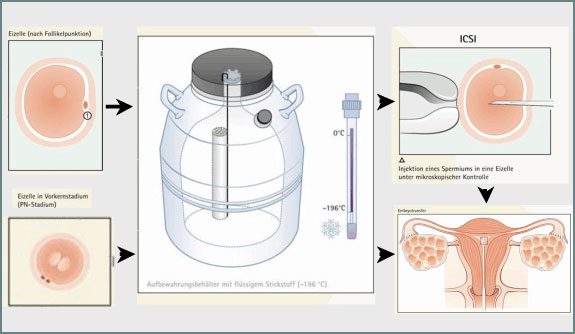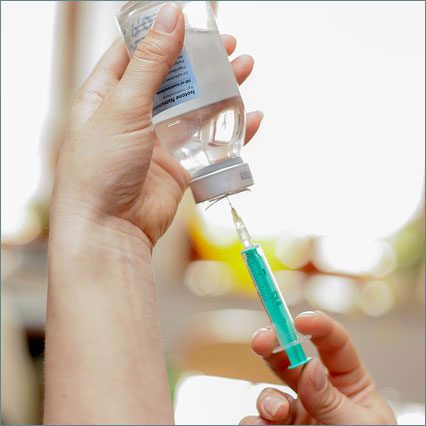Fertility sustaining measures in case of
severe diseases and
“Social Freezing”
For female patients and their partners the issue of family planning becomes crucial if they suffer from a severe disease (e.g. cancer) during their reproductive age. Will they be able to become parents? It is therefore recommendable to provide patients with comprehensive information before commencing cancer treatment about the available methods to sustain fertility and whether they are appropriate.
On the following pages we will describe options and methods for protecting fertility or creating reserves so that pregnancy and reproduction can be achieved even if fertility is lost.
More information can be found here: https://fertiprotekt.com/english/
Cryopreservation of fertilised and
unfertilised egg cells/Vitrification
Before chemotherapy or radiation therapy, there are two possibilities to freeze egg cells:
1.Fertilized eggs are frozen
Firstly the ovaries are treated with hormones. Then the matured egg cells are removed. If the woman has a long-term partner, these eggs are fertilised with the sperm by means of artificial insemination (IVF/ICSI – in vitro-fertilisation/intracytoplasmic sperm injection). One day afterwards, the fertilised egg cells (in the pre-nucleus stage) are then deep frozen. At a later time, they can be thawed, cultivated into embryos and transferred to the uterus (embryo transfer).
2.Unfertilised eggs are frozen.
If the woman is not in a long-term relationship at the time of treatment, the egg cells obtained after hormonal treatment can be frozen. A new and more gentle freezing method is used: vitrification. Once the disease is overcome and a partner is available, the egg cells can be inseminated by his sperm by IVF/ICSI-therapy.
Downregulation with GnRH-analogs/ -antagonists
Before commencing a therapy which may be harmful to the egg cells, we have the opportunity to protect them. There are medications which suppress the body’s hormone production. This causes the egg cell to rest during chemotherapy and protects them from negative influences.
Numerous studies indicate that this method can be used to prevent the ovaries from becoming damaged by such medications. However, no final proof exists on the effectiveness of this method. The effectiveness of chemotherapy for nearly all diseases will not be impaired. Only in the case of hormone-dependent breast cancer is it unclear whether the treatment is impaired.
Cryopreservation a transplantation of ovary tissue
Before a chemotherapy there is the possibility to remove the ovaries or parts of the ovaries during a laparoscopy. The removed ovarian tissue can undergo cryopreservation and be stored for years in liquid nitrogen at – 196°.
After the cancer is treated, this tissue can be implanted. Ideally, the transplanted tissue then grows and produces female sex hormones and egg cells so that the pregnancy can occur naturally or after artificial fertilisation. However, there are no precise statistics regarding the prospects of success.
The ovarian tissue is removed surgically in a cancer center. Specialised centers are subject to very strict quality standards to ensure that the ovarian tissue survives. In Germany, these are the university gynecological clinics in Bonn and Erlangen. The transplantation either occurs where the tissue was removed or at one of the two cited gynecological clinics.
Cryoconservation of sperm from ejaculate
Chemotherapy or radiotherapy can harm the male fertility. Fertility can also be impaired by surgery. To fulfill the desire for children after that treatment, there is the possibility of cryoconservation of the sperm. In this case testicular tissue can removed surgically, deep frozen and stored so that individual sperm can be used later for artificial fertilization if pregnancy is desired.
Freezing sperm from testicular tissue (TESE)
For men who do not have sperm in their ejaculate or who are unable to ejaculate, TESE (testicular sperm extraction) is a well-established strategy. It involves obtaining sperm from the testicular tissue. In outpatient surgery, several small tissue samples are surgically removed from the testicles and then frozen and stored in liquid nitrogen. Subsequently, sperm can be collected from these samples after they thaw. These sperms can be used for artificial insemination. The success of this method depends on whether there is a sufficient number of sperm in the testicular tissue capable of fertilization when they were frozen.















